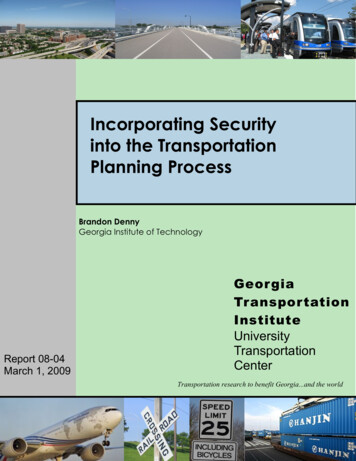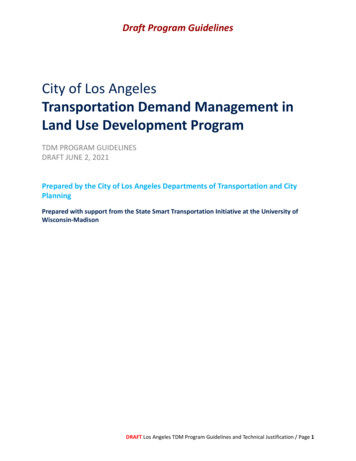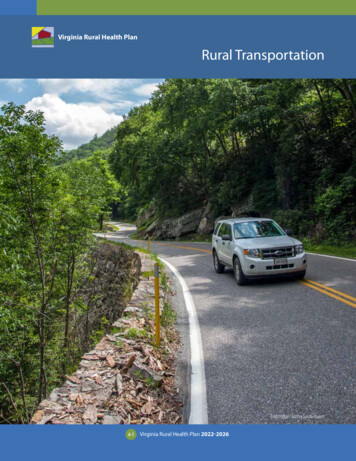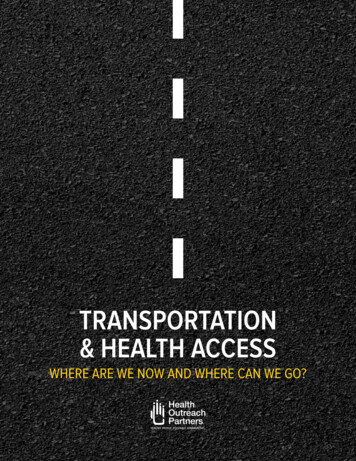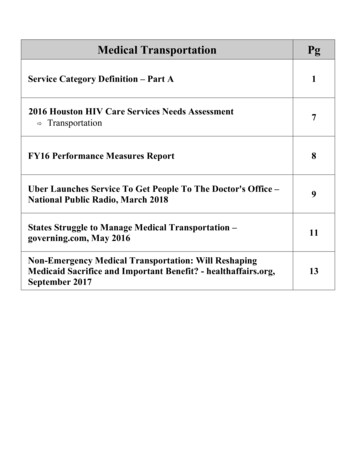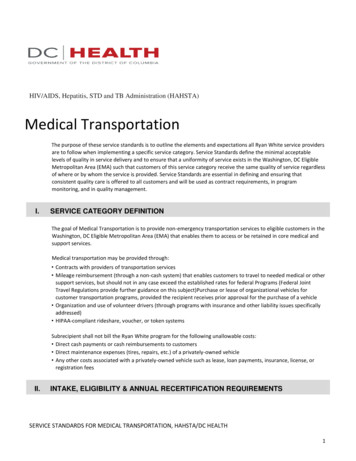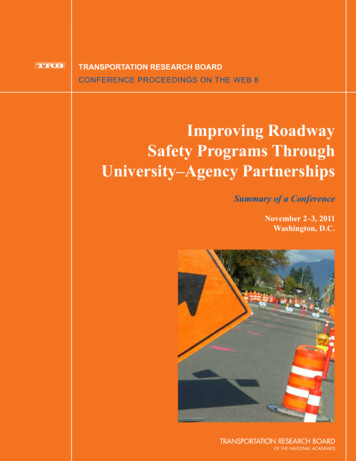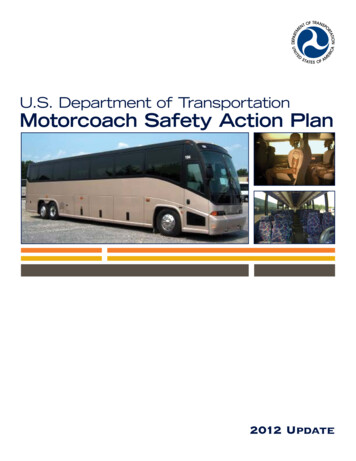
Transcription
U.S. Department of TransportationMotorcoach Safety Action Plan2012 Update
Table ofContents3State of the Industry . . . . . . . . . . 5Action Plan . . . . . . . . . . . . . . . . . 11Executive Summary . . . . . . . . . . .2012 Update n Motorcoach Safety Action PlanPriority Action Items –Completed . . . . . . . . . . . . . . . . .13Additional CompletedAction Items . . . . . . . . . . . . . . . .17On-Going MotorcoachSafety Actions . . . . . . . . . . . . . .31New MotorcoachSafety Actions . . . . . . . . . . . . .Next Steps . . . . . . . . . . . . . . . .3545Appendix A –Open NTSB MotorcoachSafety Recommendations . . . . .47Appendix B –Stakeholder Consultations . . . . .61
This pageintentionallyleft blank2Motorcoach Safety Action Plan n 2012 Update
Executive SummaryThis 2012 updatewas developedto document theDepartment’saccomplishmentssince 2009 aswell as provideinformationon in-processactivities and newcommitments madeby the Agencies toimprove the safetyof motorcoachpassengers.Motorcoaches complete approximately 750 million passenger trips each year1.Over the 10-year period of 2001 through 2010, motorcoach crashes resulted inan average of 17 motorcoach occupant fatalities per year. The U.S. Departmentof Transportation’s (DOT) original Motorcoach Safety Action Plan, issued in2009, reflected integrated activities involving five of the Department’s operatingadministrations to improve safety in this sector of the industry. The original planmay be found at he DOT remains committed to a sustained focus on motorcoach safety andto the completion of identified actions to prevent crashes, deaths, and injuries.In 2011, there were 8 serious motorcoach crashes that resulted in 28 occupantfatalities. Two of the crashes in New York and Virginia accounted for 19 fatalitiesand multiple injuries. These crashes clearly illustrated the devastation thatcan occur when individuals and companies operate outside the statutory andregulatory safety requirements. As a result, all of the involved DOT agencieswere required to increase their efforts.On July 6, 2012, President Obama signed the “Moving Ahead for Progress inthe 21st Century Act” (MAP-21), which defined the term “motorcoach” andincorporated in Subtitle G the “Motorcoach Enhanced Safety Act of 2012,”P.L. 112-141. MAP-21 includes mandates for various motorcoach rulemakingsand research projects on the crashworthiness and crash avoidance featuresof motorcoaches, as well as for improved oversight of motorcoach serviceproviders.The agencies involved committed to continuing work in this area through thisupdated plan are:Federal Highway Administration (FHWA),Federal Motor Carrier Safety Administration (FMCSA),Federal Transit Administration (FTA),National Highway Traffic Safety Administration (NHTSA),Office of the Secretary (OST),Pipeline and Hazardous Materials Safety Administration (PHMSA), andResearch and Innovative Technologies Administration (RITA).The Department will focus resources and continue coordination to ensure thatthis important work is prioritized and completed on schedule so that crashes areavoided and lives are saved.1“The Moving Ahead for Progress in the 21st Century Act” (MAP-21) defined “motorcoach” the same as an “over-the-road” busmeaning a bus characterized by an elevated passenger deck located over a baggage compartment, as found in section 3038(a)(3) of the Transportation Equity Act for the 21st Century (49 U.S.C.5310 note), but does not include: (a) a bus used in publictransportation provided by, or on behalf of, a public transportation agency; or (b) a school bus, including a multifunction schoolactivity bus.2012 Update n Motorcoach Safety Action Plan3
This pageintentionallyleft blank4Motorcoach Safety Action Plan n 2012 Update
State of the IndustryMotorcoach travel remains one of the safest modes of highway transportationin the United States, transporting approximately 750 million passengers peryear in over-the-road buses. However, during the 10-year period of 2001 through2010, motorcoach crashes have resulted in an average of 17 motorcoachoccupant fatalities per year. Some crashes also resulted in additional fatalitiesand injuries of pedestrians, drivers, and passengers of other vehicles involvedin these crashes. Each of these fatalities is a tragedy that the U.S. Departmentof Transportation strives to prevent. Passenger safety is a top priority in theDepartment and, as a result, requires added vigilance.Currently, the motorcoach industry is made up of approximately 4,000companies operating over 35,000 vehicles. In Fiscal Year (FY) 2010, FMCSAconducted 1,044 motorcoach carrier compliance reviews on these entities. Acompliance review is an in-depth examination of a motor carrier’s operationsand is used to determine the safety fitness rating of motor carriers. Themost frequently cited violations were improper or false driver records ofduty status or other violations of the hours-of-service regulations. Twentythree percent (1,901) of all the violations cited during the compliance reviewsinvolved these regulations.In 2011, there were 8 serious motorcoach crashes resulting in 28 occupantfatalities. These crashes resulted in unprecedented national focus on the safetyof motorcoach travel and motorcoach companies. Two crashes in New York andVirginia, with a total of 19 fatalities and multiple injuries, clearly illustrate thedevastation that can occur when individuals and companies operate outside thestatutory and regulatory safety requirements. The Department has continued toemphasize motorcoach safety, and the 2011 crashes increased those efforts. This2012 update recounts those activities.The motorcoach industry’s recent crash history reflects a higher averagenumber of fatalities for the past 10 years than the earlier decade despitechanges in vehicle miles traveled.52012 Update n Motorcoach Safety Action Plan
Motorcoach Driver and Passenger Fatalities (1991–2010)Figure 1:MotorcoachDriver andPassenger Fatalities(FARS2 1999–2010)Number of Fatalities4035Driver30Passenger25201510501991 1992 1993 1994 1995 1996 1997 1998 1999 2000 2001 2002 2003 2004 2005 2006 2007 2008 2009 2010Figure 1: Motorcoach Driver and Passenger Fatalities (FARS2 1991–2010)The NHTSA Fatality Analysis Reporting System data continues to show thatrollovers and roadside events (i.e., running off-road and striking roadsideobjects) occurred in about 74 percent of all motorcoach fatalities, and ejection ofmotorcoach passengers due to a rollover event represents the highest percentageof passenger fatalities, as shown in Figures 2 and 3.Motorcoach Fatalities by Most Harmful Event (FARS 2001–2010)49 Events, 171 e 2:MotorcoachFatalities by MostHarmful EventRoadside13%Figure 2: Motorcoach Fatalities by Most Harmful Event.62NHTSA’s Fatality Analysis Reporting System (FARS) contains data on a census of fatal traffic crashes in the United States andPuerto Rico. Crashes in FARS involve a motor vehicle traveling on a road customarily open to the public that results in a fatalitywithin 30 days of the crash.Motorcoach Safety Action Plan n 2012 Update
Driver and Passenger Motorcoach Fatalities (FARS 2001–2010)49 Events with 171 Fatalities – 21 Drivers and 150 Passengers90Figure 3:Driver andPassenger Fatalitiesby Ejection Modeand Type of CrashNumber of ther40302520100231240Eject1635150No Eject241010EjectDriver12No EjectPassengerFigure 3: Driver and Passenger Fatalities by Ejection Mode and Type of Crash.The Department continues to coordinate with the National Transportation SafetyBoard (NTSB) to address motorcoach safety issues.Root Cause of NTSB-Investigated Motorcoach CrashesOther6%RoadConditions6%Figure 4:Root Cause ofNTSB-InvestigatedMotorcoach CrashesMedical Condition ofBus Driver6%Driver tion,Not Driver Fault19%Figure 4: Root Cause of NTSB-Investigated Motorcoach Crashes72012 Update n Motorcoach Safety Action Plan
Root Cause of NTSB-Investigated Motorcoach FatalitiesOther7%Figure 5:Root Cause ofNTSB-InvestigatedMotorcoachFatalitiesMedical Condition ofBus Driver18%Driver ention6%Recognition,Not Driver Fault11%Figure 5: Root Cause of NTSB-Investigated Motorcoach FatalitiesSince the 2009 plan, NTSB has investigated motorcoach crashes in Saltillo, MX;Casper, WY; Doswell, VA; and New York, NY. In addition, NTSB issued 26 newrecommendations in 2010, 2011, and 2012 that impact motorcoaches.The DOT representatives participated as panelists at the NTSB’s Truck and BusSafety Forum in May 2011 and provided assistance to NTSB in the developmentof the “Report on Curbside Motorcoach Safety” issued on October 12, 2011. TheNTSB report defines curbside motorcoach operations as “a business model inwhich interstate motorcoach carriers conduct scheduled trips from one city toanother city or a destination and originate or terminate at a location other than atraditional bus terminal; most of these operations pick up or discharge passengersat one or more curbside locations (such as sidewalks or parking lots).” As noted inthe NTSB report, curbside motorcoach operations began as an inexpensive meansof travel between New York City and Boston primarily for low-income workers.Curbside operations subsequently became popular among college students andcustomers with higher incomes who took advantage of the convenience and lowprices. This is now a distinct segment of the motorcoach industry that requiresvigilant monitoring.The NTSB continues to include bus operations safety on its “Most Wanted”list. The NTSB emphasizes the need for adequate standards for roof strength,structural integrity, window glazing, and occupant protection to be developed andimplemented to ensure consistent levels of safety across the fleet. After a crash,the NTSB stresses that occupants need to be able to identify exits and quicklyleave the vehicle.8The DOT has engaged organizations and individuals outside of the Departmentto develop a collaborative process for addressing safety problems. Both FMCSAMotorcoach Safety Action Plan n 2012 Update
and NHTSA testified in two congressional hearings focused on motorcoachsafety and shared information on the limitations of our authorities and ourrecommended legislative changes to prevent additional tragedies.To further collaborate and generate more conversation and ideas, FMCSA,NHTSA, FTA, OST, FHWA, and RITA conducted four regional roundtables inAugust 2011 in Fort Worth, TX; New York, NY; Columbus, OH; and Anaheim,CA. The regional meetings culminated with the National Motorcoach SafetySummit held in Washington, DC, on September 23, 2011. The goal of thesemeetings was to identify the challenges related to motorcoach safety.Participants including drivers, labor representatives, company owners, safetymangers, tour group organizers, safety advocates, and educators helped shapethis updated plan by identifying actions necessary to increase motorcoachsafety awareness, enforcement, and education. The Department was able toforge new partnerships.The FMCSA has established a memorandum of agreement with the Departmentof Defense (DOD) to share information on the safety reviews conducted onpassenger carriers under contract to DOD. FMCSA also completed an online commercial motor vehicle awareness course that can be used by lawenforcement to become familiar with how to enforce unsafe driving violations ondrivers of motorcoaches.Additionally, on March 20, 2012, FMCSAunveiled its SaferBus iPhone/iPadapplication — a first-of-its-kind app thatprovides the public (both bus riders andtrip planners) a quick and free way toreview a bus company’s safety recordbefore buying a ticket or booking grouptravel. SaferBus provides access to safety records on nearly 6,000 interstatecommercial passenger carriers operating in the United States today, includingprivately operated motorcoach, school bus, and tour bus companies. Informationlike this is especially important as more Americans turn to motorcoaches tomeet their transportation needs. A SaferBus app search will provide: Bus Company Safety Record: The app gives access to up to 24 months ofa bus company’s safety performance record. These data provide insight intoa bus company’s performance in five safety-critical areas: unsafe driving,fatigued driving/hours-of-service compliance, driver fitness, controlledsubstances/alcohol, and vehicle maintenance. Percentiles in any area canrange between 0 (best) and 100 (worst), and are based on the company’scompliance with Federal safety standards. This information is also availableon-line at FMCSA’s Web site at: http://ai.fmcsa.dot.gov/SMS/Default.aspx.2012 Update n Motorcoach Safety Action Plan9
Bus Company Operating Authority: In addition to providing a bus company’ssafety record, the app will also notify users if that company is an illegalbus company that has been shut down by FMCSA with this language: “NOTALLOWED TO OPERATE.” Bus riders should NOT use interstate bus companiesthat do not have valid USDOT operating authority. Report a Bus Safety Complaint: SaferBus links to FMCSA’s NationalConsumer Complaint Database, enabling users to instantly submit any bussafety-related concern.On May 1, 2012, FMCSA launched a contest that challenges student softwaredevelopers to use the Agency’s raw performance data on commercial buscompanies to create new apps and on-line solutions that enable consumers tomake smart safety decisions when booking their bus travel. FMCSA hopes thatthe challenge will also raise public awareness about the availability and usefulnessof FMCSA’s bus safety data. FMCSA’s Motorcoach Safety Data Utilization StudentChallenge is open to all U.S. citizens and permanent residents who are 18 years orolder and enrolled at a fully-accredited higher education institution, or planning toenroll in the fall of 2012 or winter of 2013. Submissions are due December 31, 2012.Winners will be announced on February 28, 2013.On May 31, 2012, FMCSA shut down 26 bus operations, declaring them imminenthazards to public safety. This action is the largest single safety crackdown inFMCSA’s history. Additionally, FMCSA ordered 10 individual bus company owners,managers, and employees to cease all passenger transportation operations, whichincludes selling bus tickets to passengers. The bus companies transported over1,800 passengers a day along Interstate 95, from New York to Florida. Theseactions were the result of a year-long investigation. Federal safety investigatorsfound all of the carriers had multiple safety violations, including a continuouspattern of using drivers without valid commercial driver’s licenses (CDLs) andfailure to have alcohol and drug testing programs. In addition, the companiesoperated vehicles that had not been regularly inspected and repaired. Thecompanies’ drivers also had serious hours-of-service and driver qualificationviolations. These many safety deficiencies, individually and in combination, poseda serious safety threat to passengers and motorists on our roadways.Together, the actions and initiatives summarized above demonstrate theDepartment’s comprehensive approach to passenger carrier safety.10Motorcoach Safety Action Plan n 2012 Update
Action PlanThe 2009 plan focused on the causes of crashes and the changes that could be made to preventfuture crashes, including the following:ZZZ.Driver FatigueDriver BehaviorMedical Qualification of DriversVehicle MaintenanceOperator OversightCrash Avoidance MeasuresAdditionally, the plan focused on actions to address the root causes of fatalities and injuries and thechanges that could be made to prevent fatalities or lessen the severity of injuries, with an emphasison the following:Occupant Protection – Seat BeltsOccupant Protection – Fire SafetyOccupant Protection – Vehicle IntegrityOccupant Protection – Emergency Egress10010101101010010111010010Data Collection and AnalysisThis update to the 2009 plan outlines the actions the Department has completed, the actions thatwe continue to work on, and new actions that have been identified since 2009 that will improvemotorcoach safety in each of these areas.2012 Update n Motorcoach Safety Action Plan11
12Motorcoach Safety Action Plan n 2012 Update
Priority Action Items –CompletedThe DOT identified seven priority action items in the original plan that wouldhave the greatest impact on reducing motorcoach crashes, fatalities, andinjuries. The priority action items from the original plan that have beencompleted include the following:ZZZ.Driver Fatigue Initiate rulemaking to require electronic on-board recording devices on allmotorcoaches to better monitor drivers’ duty hours and manage fatigue.The FMCSA published an Electronic On-Board Recorders (EOBR) finalrule for companies violating the hours-of-service regulations on April 5,2010. This rule, however, was vacated by the U.S. Court of Appeals forthe Seventh Circuit on August 29, 2011. In addition, FMCSA publisheda notice of proposed rulemaking (NPRM) titled “Electronic On-BoardRecorders and Hours of Service Supporting Documents” on February1, 2011, to propose installation of EOBRs on all motorcoaches. TheFMCSA has determined that it must complete a supplemental NPRM toaddress issues raised in response to the NPRM and by the Court. Thesupplemental rulemaking and related studies are FMCSA priorities forFY 2013.132012 Update n Motorcoach Safety Action Plan
Driver Behavior Initiate rulemaking to prohibit use of cellular telephones and other devices bymotorcoach drivers.The FMCSA initiated and completed a study titled, “Synthesis ofLiterature Relating to Cellular Telephone/Personal Digital Assistant Use inCommercial Truck and Bus Operations” that collected data and informationon the risks associated with the use of cellular telephones and personaldigital assistants (PDA) in commercial truck and bus operations. Thestudy included a review of similar completed research for automobiles,an investigation of commercial motor vehicle driver behavior with suchdevices, and current industry policies regarding their use. This study isavailable at nd-BusOperations.pdf. In addition, to combat distracted driving, FMCSA issued anNPRM titled, “Limiting the Use of Wireless Communications Devices” onApril 1, 2010. This rule was finalized on September 27, 2010, and prohibitstruck and motorcoach drivers from texting while driving.The FMCSA also published an NPRM titled “Drivers of CMVs: Restrictingthe Use of Cellular Phones” on December 21, 2010. On December 2, 2011,FMCSA and PHMSA jointly published a final rule amending the FederalMotor Carrier Safety Regulations (FMCSRs) and the Hazardous MaterialsRegulations (HMR) to restrict the use of hand-held mobile telephones bydrivers of commercial motor vehicles. This final rule became effective onJanuary 3, 2012. As result, it is now illegal to talk on a handheld cellularphone while operating a commercial motor vehicle.Crash Avoidance Measures Develop performance requirements and assess the safety benefits for stabilitycontrol on motorcoaches to reduce rollover events.To reduce rollovers and directional instability of commercial vehicles,NHTSA conducted research to evaluate stability control systems forheavy trucks and motorcoaches, assessed the potential safety benefitsthat can be achieved, and developed objective performance tests forthese systems. Test data and the associated reports on the research areavailable at www.regulations.gov in docket number NHTSA-2010-0034.14Motorcoach Safety Action Plan n 2012 Update
In May 2012, NHTSA issued an NPRM to establish a new Federal safetystandard to reduce rollover and loss of directional control crashes oftruck tractors and large buses, including motorcoaches (docket numberNHTSA-2012-0065). Technology that can enhance the stability of thevehicle is particularly relevant since motorcoach rollover crashesaccount for 61 percent of motorcoach occupant fatalities. The standardwould require electronic stability control (ESC) systems on truck tractors,motorcoaches, and other large buses with a gross vehicle weight ratingof more than 11,793 kg (26,000 lb). The ESC systems use engine torquecontrol and computer-controlled braking of individual wheels to assistthe driver in maintaining control of the vehicle and maintaining itsheading. The proposal requires the ESC systems to meet definitionalcriteria and performance requirements.The MAP-21 states that the Secretary shall prescribe regulationsrequiring motorcoaches to be equipped with stability enhancingtechnology, such as electronic stability control and torque vectoring,to reduce the number and frequency of rollover crashes amongmotorcoaches by 2014, if it is determined that such a standard meets therequirements and considerations set forth in subsections (a) and (b) ofsection 30111 of title 49, United States Code.Occupant Protection – Seat Belts Initiate rulemaking to require the installation of seat belts on motorcoachesand other large buses to improve occupant protection.The NHTSA published an NPRM on August 18, 2010, titled “FederalMotor Vehicle Safety Standards: Motorcoach Definition; Occupant CrashProtection” (docket number NHTSA-2010-0112). The NPRM proposedto amend the Federal safety standard for occupant crash protection torequire, among other things, a lap/shoulder belt at all passenger seatingpositions on new buses with a gross vehicle weight rating of more than11,793 kg (26,000 lb) (except for a few excluded bus types, such as transitbuses). It also proposed to apply requirements for seat belt anchorageloads, to ensure that the seats and seat belts will be strong enough towithstand the loads imposed in serious crashes.The NHTSA received over 130 comments on the NPRM from seatmanufacturers, bus manufacturers and affiliates, large and smalltransportation providers, consumer and other organizations, and privateindividuals. The Agency has evaluated the comments and is activelyworking to complete this rulemaking action.2012 Update n Motorcoach Safety Action Plan15
The MAP-21 states that the Secretary shall prescribe regulations requiringseat belts on motorcoaches at each designated seating position by 2013.Occupant Protection – Vehicle Integrity Evaluate and develop roof crush performance requirements to enhancestructural integrity.The NHTSA completed research on multiple roof crush test proceduresand developed performance requirements. Test data, reports, and adiscussion paper on the research are available at www.regulations.gov indocket number NHTSA-2007-28793; item IDs NHTSA-2007-28793-0015,0016, 0025, and 0019. The NHTSA is preparing an NPRM for improvingthe rollover structural integrity of motorcoaches and other large buses.The MAP-21 states that the Secretary shall establish improved roof androof support standards for motorcoaches that substantially improve theresistance of motorcoach roofs to deformation and intrusion to preventserious occupant injury in rollover crashes involving motorcoaches by2014, if it is determined that such a standard meets the requirements andconsiderations set forth in subsections (a) and (b) of section 30111 of title49, U.S. Code motorcoach rollover structural integrity. This action is amongthose included in MAP-21.16Motorcoach Safety Action Plan n 2012 Update
Additional CompletedAction ItemsAdditional action items from the 2009 plan that were completedinclude the following:ZZZ.Driver Fatigue Accelerate research into fatigue issues relating to motorcoach drivers,including hours-of-service and technologies to detect driver fatigue.The FMCSA’s State partner, Florida Department of Transportation,completed two reports on motorcoach driver fatigue titled, “PotentialCauses of Driver Fatigue: A Study on Transit Bus Operations in Florida”and “Analysis of the Relationship between Operator Cumulative DrivingHours and Involvement in Preventable Collisions” in May 2011. Thesereports are available at reports.aspx. Complete a multi-faceted strategy to address sleep disorders.The FMCSA completed a report on sleep disorders affecting safedriving titled, “Evidence Report: Narcolepsy and CMV Driver Safety.”This report was published on the FMCSA Web site at 0/Narcolepsy CMV DriverSafety 1042010.pdf.Additionally, other reports on sleep apnea have also been published onthe FMCSA Web site at mep/mep-reports.htm.The FMCSA Medical Program has established Medical Expert Panelsto assist the Agency with its goal to update current, and develop new,medical fitness for duty standards and guidelines for drivers of CMVswho operate in interstate commerce.172012 Update n Motorcoach Safety Action Plan
The FMCSA Medical Program is comprised of experienced cliniciansand researchers knowledgeable in evidence-based medicine. The teamconducts background and preliminary research on relevant medicalissues, conducts systematic reviews of medical literature, and performsmeta-analyses using quantitative and qualitative models to developevidence-based recommendations. Links to the Medical Expert Panelrecommendations are located at ep/mep-reports.htm. In June 2011, the MedicalReview Board (MRB), one of FMCSA’s two Federal advisory committees,met in a public forum to discuss three topics, one of which was obstructivesleep apnea. A summary of the June 30, 2011, MRB public meeting can befound at 8Motorcoach Safety Action Plan n 2012 Update
Most recently FMCSA’s two Federal advisory committees, the MotorCarrier Safety Advisory Committee (MCSAC) and the MRB, met todevelop joint recommendations for FMCSA regarding obstructive sleepapnea. Their proceedings and recommendations can be found at http://mcsac.fmcsa.dot.gov/meeting.htm. Recommendations are listed underTask 11-05 and are expected to be incorporated into FMCSA guidancein 2012 to assist the medical community in identifying, screening, andtreating obstructive sleep apnea.Additionally, other reports on obstructive sleep apnea have beenpublished on the FMCSA Web site at ep/mep-reports.htm.The FMCSA also published driver-focused educational materials, createdin partnership with the National Sleep Foundation, on the preventionof fatigued driving, especially sleep apnea. Information is available pnea/sleep-apnea.aspx.Driver Behavior Implement driver safety history Pre-employment Screening Program (PSP).The FMCSA awarded a contract to support PSP in July 2009. Theprogram became operational in September 2009. As a result, employerscan query the system for information about prospective drivers (oncethe drivers grant permission) in advance of hiring and review a driver’ssafety history. Since the program was initiated, the average number oftransactions each month is nearly 36,000. The Web site is available athttp://www.psp.fmcsa.dot.gov. Accelerate research on driver distraction.In support of FMCSA’s cellular phone rulemaking, the Agency completedresearch on the impacts of cellular phone and personal digital assistantswhen driving. The report titled, “Distraction in Commercial Trucks andBuses: Assessing Prevalence and Risk in Conjunction with Crashes andNear-Crashes,” and dated September 2010 was included in the docket forthe associated rulemaking.192012 Update n Motorcoach Safety Action Plan
Increase outreach and enforcement activities emphasizing improvingdriver behavior.The Commercial Vehicle Safety Alliance (CVSA) annually coordinatesOperation Safe Driver and the International Roadcheck across NorthAmerica to increase commercial motor vehicle and non-commercialvehicle traffic enforcement as well as commercial motor vehicleinspections. Activities include safety belt enforcement, driver roadsideinspections, driver regulatory compliance, implementation of commercialdriver educational and awareness programs to the motor carrierpopulation, and safety awareness to the motoring public about operationsaround commercial motor vehicles.Passenger Carrier Strike Force activities are one part of the overallcompliance review and inspection program for motorcoach companies.FMCSA, in partnership with State and local law enforcement, conductsthe annual National Passenger Carrier Strike Force event. In FY 2012,additional focus was placed on intercity curbside operators.Passenger carrier strike force operations also address motorcoachtransportation at casinos, theme parks, and similar destinations and areconducted across the Nation continuously. The Western Region recentlycompleted a surprise overnight strike force inspecting northbound busesalong the New Mexico border. The Eastern Region conducted a regionalstrike force in May 2012. The focus of the strike force was inspections ofcurbside operators in the inner cities and destination inspections relatedto year-end school field trips at popular locations along the east coast.In addition, high risk motorcoach operations were targeted for on-siteinvestigations. Finally, concentrated traffic enforcement was conducted inhigh volume bus traffic corridors during the event.Medical Qualification of Drivers Conduct research on driver risk factors.The FMCSA initiated a driver characteristics study in July 2009. The reportwas completed in January 2011 and is titled, “The Safety Performance ofPassenger Carrier Drivers.” The report is
(3) of the Transportation Equity Act for the 21st Century (49 U.S.C.5310 note), but does not include: (a) a bus used in public transportation provided by, or on behalf of, a public transportation agency; or (b) a school bus, including a multifunction school activity bus.

